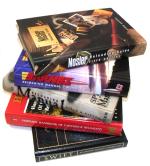 There is great satisfaction in shooting handloaded ammunition, that has been assembled with an optimized selection of components, “optimized” defined as yielding the best possible combination ingredients for a specific application. The application may be low cost target ammo, something for maximum bullet expansion on big game, an emphasis on flat trajectory, or minimal size 3 shot groups. Arriving at an optimized result requires a degree of experimentation; running up and down the pressure and velocity scales until the desired results are achieved, frequently utilizing combinations of components that do not appear in mainstream reloading manuals. The omission is not because these combinations are inherently unsafe, but rather because most manuals are published by component suppliers, suppliers who understandably do not include components produced by competitors. Therefore, in the course of routine experimentation, is it very possible to use combinations of credible and safe components, and still move out beyond the safe harbor of mainstream reloading manuals.
There is great satisfaction in shooting handloaded ammunition, that has been assembled with an optimized selection of components, “optimized” defined as yielding the best possible combination ingredients for a specific application. The application may be low cost target ammo, something for maximum bullet expansion on big game, an emphasis on flat trajectory, or minimal size 3 shot groups. Arriving at an optimized result requires a degree of experimentation; running up and down the pressure and velocity scales until the desired results are achieved, frequently utilizing combinations of components that do not appear in mainstream reloading manuals. The omission is not because these combinations are inherently unsafe, but rather because most manuals are published by component suppliers, suppliers who understandably do not include components produced by competitors. Therefore, in the course of routine experimentation, is it very possible to use combinations of credible and safe components, and still move out beyond the safe harbor of mainstream reloading manuals.The effects of component substitution and varying process
Substituting one bullet for another of the same weight within a specific handload recipe, can have a dramatic effect on outcome. Where overall maximum cartridge length must remain consistent, compensation for variations in bullet length are accommodated by varying seating depth; longer bullets get seated more deeply, with a corresponding reduction in the space within the cartridge that contains the powder charge. A decrease in this space, while maintaining the same powder charge, will yield an increase in pressure.
 Pictured above are .458″ Sierra Pro Hunter, Nosler Partition and Barnes XFN, all are 300 grains, however, the overall length of the bullet varies significantly, .776″, .807″ and 1.119″ respectively.
Pictured above are .458″ Sierra Pro Hunter, Nosler Partition and Barnes XFN, all are 300 grains, however, the overall length of the bullet varies significantly, .776″, .807″ and 1.119″ respectively.The cutaway cartridges to the right illustrate the obvious differences in net cartridge capacity, after seating the various bullets to their cannelure for a proper overall cartridge length of 2.550″. Working from a common load defined in a mainstream manual, and substituting only these bullets of the same weight, while maintaining a common overall cartridge length, the maximum average pressure range could be as great as 25,000~42,000 PSI; ranging from safe for a trapdoor design firearm to excessive for a modern Model 1895 Marlin.
Even primer type substitution can lead to unexpected results. It is possible to replace a standard large rifle primer with a hot magnum primer, and have pressure and performance decline. Improper application of a magnum primer, behind a heavy or compressed powder charge, may propel both powder and bullet forward into the throat of the barrel, a handful of milliseconds prior to powder ignition. The result would be powder burning in an area of greater than anticipated volume and, therefore, producing lower pressure than a comparable load with a standard large rifle primer. Of course, the result of misapplication of a magnum primer would vary with powder characteristics; faster burning, lower volume charges might react just the opposite, and generate higher than anticipated pressure when ignited with a magnum primer.
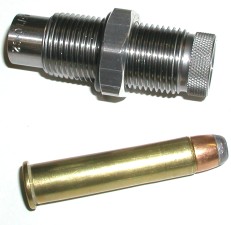 Related to the issue of time of bullet retention, or movement prior to significant ignition, is the employed method of case crimping bullets. A heavy roll crimp will typically hold a bullet in place a bit longer upon ignition, insuring: a more consistent powder chamber volume as ignition develops, more uniform round to round pressure levels and more complete powder burn. Most reloading manuals do not note which cartridges should receive a roll crimp, and the existence of a cannelure on a bullet does not mean a roll crimp is required. A roll crimp will produce greater pressure than a taper crimp. A Lee collet type crimping die (left) works well with: most nearly straight wall cartridges, cartridges fed through a tubular magazine, and heavy recoiling cartridges – however, its use may be inconsistent with reloading manual data and procedures.
Related to the issue of time of bullet retention, or movement prior to significant ignition, is the employed method of case crimping bullets. A heavy roll crimp will typically hold a bullet in place a bit longer upon ignition, insuring: a more consistent powder chamber volume as ignition develops, more uniform round to round pressure levels and more complete powder burn. Most reloading manuals do not note which cartridges should receive a roll crimp, and the existence of a cannelure on a bullet does not mean a roll crimp is required. A roll crimp will produce greater pressure than a taper crimp. A Lee collet type crimping die (left) works well with: most nearly straight wall cartridges, cartridges fed through a tubular magazine, and heavy recoiling cartridges – however, its use may be inconsistent with reloading manual data and procedures.The standard rules do not apply
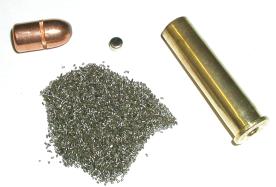 Handload experimentation, at least at the level of constructing new component combinations, is probably required to achieve optimal results, and experimentation, even at a modest level, can lead to unexpected or unpredictable results. So if experimentation is necessary, and results can be unpredictable, how does a handloader safeguard the effort? The most frequent suggestion is for the handloader to look to the traditional signs of excessive pressure, however, bright spots on case heads, internal radial fractures, neck splits, an excessive increase in case diameter forward of the extractor groove, a flat primer, etc.. Unfortunately, these are indicators primarily applicable on to strong bolt action rifles or falling block designs, as the symptoms may not appear until 65,000 PSI+ pressure levels have been reached. For other types of firearm designs, these pressure levels may be excessive to the point of failure. Consequently, a gun could be rendered useless, or even destroyed, without ever observing any traditional signs of excessive pressure. Rule of thumb – If traditional signs of excessive pressure appear, you can be sure there is excessive pressure, but if you don’t see these signs, you cannot assume pressure levels are safe without the support of other information.
Handload experimentation, at least at the level of constructing new component combinations, is probably required to achieve optimal results, and experimentation, even at a modest level, can lead to unexpected or unpredictable results. So if experimentation is necessary, and results can be unpredictable, how does a handloader safeguard the effort? The most frequent suggestion is for the handloader to look to the traditional signs of excessive pressure, however, bright spots on case heads, internal radial fractures, neck splits, an excessive increase in case diameter forward of the extractor groove, a flat primer, etc.. Unfortunately, these are indicators primarily applicable on to strong bolt action rifles or falling block designs, as the symptoms may not appear until 65,000 PSI+ pressure levels have been reached. For other types of firearm designs, these pressure levels may be excessive to the point of failure. Consequently, a gun could be rendered useless, or even destroyed, without ever observing any traditional signs of excessive pressure. Rule of thumb – If traditional signs of excessive pressure appear, you can be sure there is excessive pressure, but if you don’t see these signs, you cannot assume pressure levels are safe without the support of other information.Having fun with .45-70 Schizophrenia
There were a good number of black powder cartridges introduced in the latter part of the 19th century that offer excellent potential as modern hunting cartridges. Originally limited in performance by then existing technology; black powder, weak cartridge cases, and used in structurally weak firearms, these cartridges can now produce serious levels of performance. With improved case strength, bullets propelled by smokeless powder, and fired from much refined firearms, they can compete with virtually any modern round of similar type and purpose. The .45-70 Government is one of these gems, offering a solid combination of power and accuracy, which makes it an excellent hunting round, as well as a fun recreational target shooter. In standard form, the cartridge is very tame, but certainly enough gun for deer, boar and black bear. When loaded to the top end of the range, the cartridge is suitable for the largest North American game at near ranges. The heavy hitter level of performance is achieved through the use of handloads or specialized ammunition that exceeds SAAMI maximum average pressure standards for this cartridge, in conjunction with specific modern firearms of exceptional strength.
Loaded to SAAMI specifications, the .45-70 would perform about the same as it did when first introduced as a black powder military cartridge. Loaded to modern high performance levels, the original firearms would fail at the resulting chamber pressure. Curiously, the use of modern performance hardware, operating at performance pressures elevated above SAAMI standards, is based upon an informal and not completely mutual agreement. Virtually no firearm company, even those producing rifles recommended for use within credible reloading manuals, currently endorses the use of their product in conjunction with these hot handloads, or specialized factory performance ammo. The general consensus is that the companies fear product liability suits, but I think their reason is more basic, it would not be prudent for them to accept responsibility for products, information and people not within their control or coordination. The firearm manufacturer’s solution – the 450 Marlin, a .45-70 in belted case and expensive clothing. At this time I believe they not been able to sell this substitute over the appeal of the original cartridge. When I had the choice, I went with the .45-70, even if only as a result from my belief that 9 of 10 new cartridges go obsolete within the three to five years following their introduction, even the ones that make sense. Besides, if anyone kills the 450 Marlin, it will be the single source brass that sells for 25% more than the .45-70 and Barnes with their buck+ a bullet marketing.
The .45-70 performance load logic
As one letter writer expressed, I believe in all uppercase letters with several exclamation points that only highlighted the individual’s gender insecurities, “WHY NOT JUST STUFF MORE POWDER IN A .30-30 AND MAKE IT AN ULTRA MAG!!!”. The .45-70 Government carries an original firearm pressure specification of 28,000 PSI, the .30-30 standard is 42,000 PSI. A number of modern design lever guns chambered for both are approximately 40,000 PSI safe. Performance loads for the .45-70 only more fully utilize this design capacity, rather than honoring a limit for the .45-70 consistent with safe use in old trapdoor rifles. In addition, with approximately 40% greater case capacity than the .30-30, the .45-70’s charge can be increased a bit, with proper powder selection, without running into disproportionately sharp pressure increases – see earlier comments on powder chamber volume effects on pressure. In regard to the age of the .45-70 as a performance limiting factor, the only thing old about modern .45-70 ammo and firearms is the origin of the cartridge name.

The .45-70 can easily out perform the .444 Marlin, and it is not really outdistanced by the 450 Marlin. That modern beefy Ruger No. 1 chambered for the .45-70, is could just have easily finished the manufacturing process as a .458 Winchester Magnum, or .416 Rigby. And that brass the .45-70 is coined and extruded from, could have just as easily been a beltless .375 Ultra Mag. Subsequently, the issue isn’t whether or not the .45-70 can be used at higher than SAAMI spec pressure level, but rather how much higher, and what firearms are suitable for what pressure levels. In the case of the person who question’s the .45-70’s potential, I always try to be polite in response, pointing to the differences between original firearms chambered for the cartridge and modern firearms, the litany of professional reloading manuals providing escalated pressure producing data for the cartridge, and every enthusiast firearm magazine published since around 1956 that has supported performance handloading.
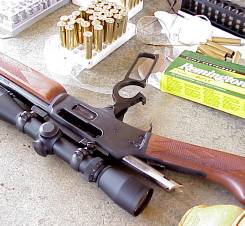 I can say, with some degree of certainty, the designed strength of the modern Marlin 1895 .45-70 can handle performance loads as noted in popular reloading manuals; and any ammo at or something below 40,000 PSI. The current 1895 G is the same gun as the M version, tangibly different only in chamber, barrel thread type and ejection port dimensions. Ruger No. 1 rifles are routinely chambered for large diameter cases generating 55,000 PSI+ pressure levels, and I have been shooting a Tropical model rebarreled and chambered for a wildcat based on the .378 Weatherby cartridge. Neither the Model 1895 Marlin, or the No. 1 will have a problem with reasonable .45-70 loads, loads comparable to those appearing in mainstream reloading manuals identified specifically for use with the Marlin 1895 and, separately, for the Ruger No.1.
I can say, with some degree of certainty, the designed strength of the modern Marlin 1895 .45-70 can handle performance loads as noted in popular reloading manuals; and any ammo at or something below 40,000 PSI. The current 1895 G is the same gun as the M version, tangibly different only in chamber, barrel thread type and ejection port dimensions. Ruger No. 1 rifles are routinely chambered for large diameter cases generating 55,000 PSI+ pressure levels, and I have been shooting a Tropical model rebarreled and chambered for a wildcat based on the .378 Weatherby cartridge. Neither the Model 1895 Marlin, or the No. 1 will have a problem with reasonable .45-70 loads, loads comparable to those appearing in mainstream reloading manuals identified specifically for use with the Marlin 1895 and, separately, for the Ruger No.1.Before I go any further, I need to say what should be obvious, the .45-70 can be pumped up, but still only within the weakest link in the handloading chain, in this case, the firearm. The Marlin is not designed to handle pressures suitable for the Ruger No. 1, and the Ruger No. 1 is not suitable for loading this cartridge to Ultra Mag pressure levels. This whole series of articles is devoted to my attempt to find increased performance within safe pressure levels, and within the capacity of the various rifles chambered for this cartridge. My overall objective is to be able to use my .45-70 guns over a broad spectrum of application, from light loads to large North American game. Even so, I do not see the .45-70 as much more than a 100~150 yard cartridge, and I do not see it as an ideal gun for hunting large bear. I do not see the .45-70 as a .458 Winchester Magnum replacement, nor a replacement for a flat shooting .338 bore magnum.
https://www.whackydata.com – avoiding pitfalls and pot holes along the way
 I am alarmed by the number of people who believe the required use of a hammer to drive open a rifle bolt, after firing a handload, is not an indication of excessive pressure. I even recently read an exchange in a popular firearm print publication’s “Ask the Experts” section, where a reader stated he was unable to attain the velocity indicated with handload data published in an earlier issue of the magazine. The “expert” told the reader not to be concerned, but rather just keep adding powder until the published velocity was attained. I reread the passage several times, and double checked the cover for an April 1st date. The Internet and periodicals are a mixed blessing when it comes to handloading data sources. There are some great Internet sources: Accurate, Alliant, Hodgdon, IMR, and RamShot are just a few that come to mind. On the other hand, there are many sources that can get you in trouble.
I am alarmed by the number of people who believe the required use of a hammer to drive open a rifle bolt, after firing a handload, is not an indication of excessive pressure. I even recently read an exchange in a popular firearm print publication’s “Ask the Experts” section, where a reader stated he was unable to attain the velocity indicated with handload data published in an earlier issue of the magazine. The “expert” told the reader not to be concerned, but rather just keep adding powder until the published velocity was attained. I reread the passage several times, and double checked the cover for an April 1st date. The Internet and periodicals are a mixed blessing when it comes to handloading data sources. There are some great Internet sources: Accurate, Alliant, Hodgdon, IMR, and RamShot are just a few that come to mind. On the other hand, there are many sources that can get you in trouble.As a personal discipline, I’ve never use unsolicited handload data received via email, or information appearing within public forums, or taken recipes from web sites that publish untested and/or uncontrolled data submitted by the same public who thought a Bill Clinton presidency was a good idea. While I frequently use information from reloading manuals published by established component suppliers, data supported with pressure testing, I don’t pull information out of many monthly magazines. In fact, when an inexperienced handloader writes to me regarding data published on Real Guns, I always tell them not to use my data, but rather begin with professionally prepared reloading manuals that offer: instruction, cautions, theory of operation for cartridge and rifle, and data that has been pressure tested utilizing industry prescribed methods. I’m not suggesting all web sites containing handload data are a problem, quite the contrary, there are many excellent sites. I am saying all data needs to be reviewed, compared, understood and tested to determine if safe, and this validating requires some level of expertise on the part of the person utilizing the data.
Quantifying pressure levels
I came to the conclusion, with safety and preservation of life, limb and firearms key objectives within my handloading activity, I would need to find a reasonable method of monitoring chamber pressure if I was going to press on with .45-70 handload development. Of the methods readily available: pressure transducer, strain gage, accelerometer, and predictive software, use of strain gage based technology probably offers the best fit in terms of cost and relative accuracy. Pressure transducers and test barrels, coupled to a universal receiver, would be the most accurate, but cost prohibitive. A packaged accelerometer was potentially an acceptable solution, but data collection is less precise than other means, as accelerometers are susceptible to motion dampening caused by less than solid and stationary mounting.
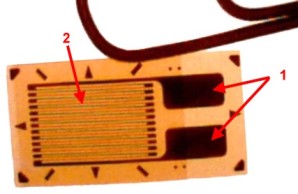 Strain gages have seen use within many industries for an extended period of time. As material is placed under stress, the amount of strain or change in the dimension of surface of the material under the gauge is measured. This change is interpreted through calculation into a unit of measure consistent with the force causing the change, most commonly by software or a program embedded into a test instrument. In the case of gun barrel strain caused by internal pressure, the reported unit of measure is estimated PSI.
Strain gages have seen use within many industries for an extended period of time. As material is placed under stress, the amount of strain or change in the dimension of surface of the material under the gauge is measured. This change is interpreted through calculation into a unit of measure consistent with the force causing the change, most commonly by software or a program embedded into a test instrument. In the case of gun barrel strain caused by internal pressure, the reported unit of measure is estimated PSI.A typical strain gage used for this type of application is pictured above next to the loop of a small paper clip, it is a uniaxial single grid design. Fundamentally, the gage is a conductor, zigzagged (2) to increase its length without a small surface area, less than half an inch on the long side in this case, and bonded to a polymer insulator. Leads are soldered to the copper pads (1) that connect the gage to the strain gage meter. Amongst other factors, strain gages are rated by levels of resistance, for this application approximately 350 ohms. In use, the gage is bonded to a specific area of a gun barrel and, when the gun is discharged, pressures acting on the barrel stretch (strain) the barrel and gage altering the gage’s resistance. This resistance change is measured and interpreted into estimated pressure.
I was able to locate a circuit diagram and material list that would allow me to build my own strain meter, and I did find source code for a program that would interpret changes in resistance at the strain gage into estimates of pressure. After review, however, I felt the construction project might introduce other factors, like my really lousy soldering ability, that could make any recorded data less than credible, so I elected to go with a Oehler Model 43, and the option of strain gage measurement capability and supporting software.
The Oehler Model 43 Personal Ballistic Laboratory
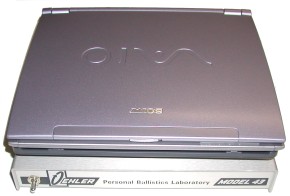 You know how you can pick up a copy of Guns & Blammo where the writer, in very clean and pressed hunting togs, plugs his rifle into an Oehler Model 43, and cranks out tons of super accurate data and nifty charts? There may be just a bit required in the way of effort required, and the equipment does have some limitations. I am not suggesting this method of pressure estimating does not work, nor am I attempting to disparage the Oehler Model 43, I’m only suggesting use of this equipment is not like breaking out a chronograph and pulling data after a 5 minute setup. Maybe if I had those hunting togs?
You know how you can pick up a copy of Guns & Blammo where the writer, in very clean and pressed hunting togs, plugs his rifle into an Oehler Model 43, and cranks out tons of super accurate data and nifty charts? There may be just a bit required in the way of effort required, and the equipment does have some limitations. I am not suggesting this method of pressure estimating does not work, nor am I attempting to disparage the Oehler Model 43, I’m only suggesting use of this equipment is not like breaking out a chronograph and pulling data after a 5 minute setup. Maybe if I had those hunting togs?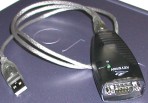 The Oehler Model 43 is the aluminum box residing under the notebook computer in the picture above; about 11″Wx9D”x1¾H”, weighing approximately 4 lbs. The Model 43 is compact but, unlike most chronographs, it is not a stand alone unit. An owner provided computer, linked to the M43 with Oehler software installed, is required to make the equipment functional. Because the Oehler Model 43 is rechargeable battery powered and, therefore portable, it makes sense to connect the unit to a portable computer. The link between the computer and the Model 43 is via an RS232 cable (supplied by Oehler), however, an RS232 to USB converter like the Kayspan unit (pictured above left), can be used if the host computer does not have an RS232 port.
The Oehler Model 43 is the aluminum box residing under the notebook computer in the picture above; about 11″Wx9D”x1¾H”, weighing approximately 4 lbs. The Model 43 is compact but, unlike most chronographs, it is not a stand alone unit. An owner provided computer, linked to the M43 with Oehler software installed, is required to make the equipment functional. Because the Oehler Model 43 is rechargeable battery powered and, therefore portable, it makes sense to connect the unit to a portable computer. The link between the computer and the Model 43 is via an RS232 cable (supplied by Oehler), however, an RS232 to USB converter like the Kayspan unit (pictured above left), can be used if the host computer does not have an RS232 port.
In addition to the link between the computer and Model 43 chassis, there are connectors on the rear panel of the Model 43 to accommodate various standard and optional features. There is a jack for each of the sky screen shielded cables, a modular jack for an optional acoustic target that requires a downrange amplifier and set of microphones, a strain gage input via a modular jack, and the unit’s battery charger. A couple of things missing that most people have come to expect in electronic equipment; some form of power indicator light, and perhaps a battery charge status indicator so the unit does not have to be connected to a computer to know if the battery is fully charged – nothing serious.
 Oehler Chronographs employ a proof channel, which is actually pretty nice. I’m sure most people have had a range session where chronograph readings are suspect; screens too close, too much muzzle blast, subsonic shock wave distortions… Oehler units take two reads for shot fired, post the reading and the difference between the two to highlight any disparity.
Oehler Chronographs employ a proof channel, which is actually pretty nice. I’m sure most people have had a range session where chronograph readings are suspect; screens too close, too much muzzle blast, subsonic shock wave distortions… Oehler units take two reads for shot fired, post the reading and the difference between the two to highlight any disparity.The first screen starts the timer, screen second and third are independent stop screens. The Model 43 comes with a 2′ bar, with the screen for the proof channel mounted precisely at the midway position on the bar. Oehler also offers an optional set up with stands and a 4′ bar for $50 above the base cost of the Model 43. The Model 43 software allows for various total distances between the outside sensors, the center sensor must always split the difference.
If you have been working with a Chrony or a Pact Chronograph you’ll notice a couple of things; the active area above the sensors is larger and the sensors are all connected to individual shielded cables. In use, the cables are tape wrapped so they are more manageable in use.
 If you stop at this point in features, you’ve got a really reliable and accurate chronograph. This cost of this basic package is $800 and the user needs to provide a computer to have a functional system. Besides the Model 43 operating software, the package also includes a current copy of Ballistic Explorer, a full featured external ballistics program, that can import pertinent data from the Model 43 software. All software is distributed on CD. By comparison, a fully functional and portable Oehler three screen Model 35 runs about $225, which means the M43 is not something to buy solely to use as a chronograph.
If you stop at this point in features, you’ve got a really reliable and accurate chronograph. This cost of this basic package is $800 and the user needs to provide a computer to have a functional system. Besides the Model 43 operating software, the package also includes a current copy of Ballistic Explorer, a full featured external ballistics program, that can import pertinent data from the Model 43 software. All software is distributed on CD. By comparison, a fully functional and portable Oehler three screen Model 35 runs about $225, which means the M43 is not something to buy solely to use as a chronograph.If the intention is to use the Model 43 to estimate pressure, Oehler offers a “Pressure Starter Kit” for an additional $170. The kit comes packaged in a larger orange Black & Decker case, which isn’t really oversized considering all the things that come packed inside.
The kit is very well thought out in that everything required to mount a strain gage, including instructions, was considered. One walk through the setup on a firearm and each tool and component will be used at least once, and not one more piece of material or tool other than what is included in the kit will be required.

Before I received the material, I was concerned I would have a hard time replenishing supplied, but even the more specialized items required on not Oehler proprietary, and can be located on line from a number of electrical supply resellers, as well as through local supply. Generally, there are strain gages, chemicals and application supplies to surface clean and adhesives to mount them to the firearm. There is a soldering iron and prefabricated wire leads with modular jacks, used to connect the strain gage to the M43 console, and epoxy to protect the strain gage when in place.
No pain, no gain
 The paragraph to the left if a clip from the M43’s very complete manual. Strain gages need very clean bare metal surfaces, so it would not be reasonable to expect one can be mounted on a blued surface, or stainless without serious chemical cleaning and roughing up the surface on either. One of the reasons I purchased a Ruger No. 1 was so I would not inflict expensive damage to my Guide Gun, and because it would be less difficult to refinish the stainless surface of the Ruger when the project was complete. Gage mounting is critical, and requires care to insure accuracy of readings when connected to the console. There are some other limitation for the equipment is regard to application. Very heavy barrels that exceed .500″ in chamber wall thickness may not read accurately as the dimensional change upon firing the gun may be too minor. The gage cannot be mounted easily on rotating surfaces such as a pistol cylinder, as there is a large 4′ long phone line size lead wire connected to the small gage that would get in the way. Auto pistols or any form of shrouded barrel would be out, as would any firearm that did not allow the gage to be mounted half way along the chamber, without being right up against the support of the firearm’s receiver. Straight cases read more accurately than bottle neck cartridges. My objective is not to downgrade the usefulness of the M43, but it is important to note this is not a piece of stick-on or bolt on equipment, it’s use will damage the firearm’s appearance and there are some restrictions in applications. Because I am putting a lot into the .45-70 handloading project, and this does represent something of personal interest in developing firearm knowledge through experimentation, the effort was worth the compromises.
The paragraph to the left if a clip from the M43’s very complete manual. Strain gages need very clean bare metal surfaces, so it would not be reasonable to expect one can be mounted on a blued surface, or stainless without serious chemical cleaning and roughing up the surface on either. One of the reasons I purchased a Ruger No. 1 was so I would not inflict expensive damage to my Guide Gun, and because it would be less difficult to refinish the stainless surface of the Ruger when the project was complete. Gage mounting is critical, and requires care to insure accuracy of readings when connected to the console. There are some other limitation for the equipment is regard to application. Very heavy barrels that exceed .500″ in chamber wall thickness may not read accurately as the dimensional change upon firing the gun may be too minor. The gage cannot be mounted easily on rotating surfaces such as a pistol cylinder, as there is a large 4′ long phone line size lead wire connected to the small gage that would get in the way. Auto pistols or any form of shrouded barrel would be out, as would any firearm that did not allow the gage to be mounted half way along the chamber, without being right up against the support of the firearm’s receiver. Straight cases read more accurately than bottle neck cartridges. My objective is not to downgrade the usefulness of the M43, but it is important to note this is not a piece of stick-on or bolt on equipment, it’s use will damage the firearm’s appearance and there are some restrictions in applications. Because I am putting a lot into the .45-70 handloading project, and this does represent something of personal interest in developing firearm knowledge through experimentation, the effort was worth the compromises.I’m going to take a break here as the next part addresses the details of mounting and wiring the strain gage, and the first results at the range. I don’t want to bore visitors to death with this dry material, but hopefully the conclusion with some new .45-70 load data will make the exercise worthwhile.
Thanks,
Joe
 There is great satisfaction in shooting handloaded ammunition, that has been assembled with an optimized selection of components, “optimized” defined as yielding the best possible combination ingredients for a specific application. The application may be low cost target ammo, something for maximum bullet expansion on big game, an emphasis on flat trajectory, or minimal size 3 shot groups. Arriving at an optimized result requires a degree of experimentation; running up and down the pressure and velocity scales until the desired results are achieved, frequently utilizing combinations of components that do not appear in mainstream reloading manuals. The omission is not because these combinations are inherently unsafe, but rather because most manuals are published by component suppliers, suppliers who understandably do not include components produced by competitors. Therefore, in the course of routine experimentation, is it very possible to use combinations of credible and safe components, and still move out beyond the safe harbor of mainstream reloading manuals.
There is great satisfaction in shooting handloaded ammunition, that has been assembled with an optimized selection of components, “optimized” defined as yielding the best possible combination ingredients for a specific application. The application may be low cost target ammo, something for maximum bullet expansion on big game, an emphasis on flat trajectory, or minimal size 3 shot groups. Arriving at an optimized result requires a degree of experimentation; running up and down the pressure and velocity scales until the desired results are achieved, frequently utilizing combinations of components that do not appear in mainstream reloading manuals. The omission is not because these combinations are inherently unsafe, but rather because most manuals are published by component suppliers, suppliers who understandably do not include components produced by competitors. Therefore, in the course of routine experimentation, is it very possible to use combinations of credible and safe components, and still move out beyond the safe harbor of mainstream reloading manuals.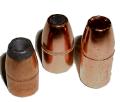
 Pictured above are .458″ Sierra Pro Hunter, Nosler Partition and Barnes XFN, all are 300 grains, however, the overall length of the bullet varies significantly, .776″, .807″ and 1.119″ respectively.
Pictured above are .458″ Sierra Pro Hunter, Nosler Partition and Barnes XFN, all are 300 grains, however, the overall length of the bullet varies significantly, .776″, .807″ and 1.119″ respectively. Related to the issue of time of bullet retention, or movement prior to significant ignition, is the employed method of case crimping bullets. A heavy roll crimp will typically hold a bullet in place a bit longer upon ignition, insuring: a more consistent powder chamber volume as ignition develops, more uniform round to round pressure levels and more complete powder burn. Most reloading manuals do not note which cartridges should receive a roll crimp, and the existence of a cannelure on a bullet does not mean a roll crimp is required. A roll crimp will produce greater pressure than a taper crimp. A Lee collet type crimping die (left) works well with: most nearly straight wall cartridges, cartridges fed through a tubular magazine, and heavy recoiling cartridges – however, its use may be inconsistent with reloading manual data and procedures.
Related to the issue of time of bullet retention, or movement prior to significant ignition, is the employed method of case crimping bullets. A heavy roll crimp will typically hold a bullet in place a bit longer upon ignition, insuring: a more consistent powder chamber volume as ignition develops, more uniform round to round pressure levels and more complete powder burn. Most reloading manuals do not note which cartridges should receive a roll crimp, and the existence of a cannelure on a bullet does not mean a roll crimp is required. A roll crimp will produce greater pressure than a taper crimp. A Lee collet type crimping die (left) works well with: most nearly straight wall cartridges, cartridges fed through a tubular magazine, and heavy recoiling cartridges – however, its use may be inconsistent with reloading manual data and procedures. Handload experimentation, at least at the level of constructing new component combinations, is probably required to achieve optimal results, and experimentation, even at a modest level, can lead to unexpected or unpredictable results. So if experimentation is necessary, and results can be unpredictable, how does a handloader safeguard the effort? The most frequent suggestion is for the handloader to look to the traditional signs of excessive pressure, however, bright spots on case heads, internal radial fractures, neck splits, an excessive increase in case diameter forward of the extractor groove, a flat primer, etc.. Unfortunately, these are indicators primarily applicable on to strong bolt action rifles or falling block designs, as the symptoms may not appear until 65,000 PSI+ pressure levels have been reached. For other types of firearm designs, these pressure levels may be excessive to the point of failure. Consequently, a gun could be rendered useless, or even destroyed, without ever observing any traditional signs of excessive pressure. Rule of thumb – If traditional signs of excessive pressure appear, you can be sure there is excessive pressure, but if you don’t see these signs, you cannot assume pressure levels are safe without the support of other information.
Handload experimentation, at least at the level of constructing new component combinations, is probably required to achieve optimal results, and experimentation, even at a modest level, can lead to unexpected or unpredictable results. So if experimentation is necessary, and results can be unpredictable, how does a handloader safeguard the effort? The most frequent suggestion is for the handloader to look to the traditional signs of excessive pressure, however, bright spots on case heads, internal radial fractures, neck splits, an excessive increase in case diameter forward of the extractor groove, a flat primer, etc.. Unfortunately, these are indicators primarily applicable on to strong bolt action rifles or falling block designs, as the symptoms may not appear until 65,000 PSI+ pressure levels have been reached. For other types of firearm designs, these pressure levels may be excessive to the point of failure. Consequently, a gun could be rendered useless, or even destroyed, without ever observing any traditional signs of excessive pressure. Rule of thumb – If traditional signs of excessive pressure appear, you can be sure there is excessive pressure, but if you don’t see these signs, you cannot assume pressure levels are safe without the support of other information.
 I can say, with some degree of certainty, the designed strength of the modern Marlin 1895 .45-70 can handle performance loads as noted in popular reloading manuals; and any ammo at or something below 40,000 PSI. The current 1895 G is the same gun as the M version, tangibly different only in chamber, barrel thread type and ejection port dimensions. Ruger No. 1 rifles are routinely chambered for large diameter cases generating 55,000 PSI+ pressure levels, and I have been shooting a Tropical model rebarreled and chambered for a wildcat based on the .378 Weatherby cartridge. Neither the Model 1895 Marlin, or the No. 1 will have a problem with reasonable .45-70 loads, loads comparable to those appearing in mainstream reloading manuals identified specifically for use with the Marlin 1895 and, separately, for the Ruger No.1.
I can say, with some degree of certainty, the designed strength of the modern Marlin 1895 .45-70 can handle performance loads as noted in popular reloading manuals; and any ammo at or something below 40,000 PSI. The current 1895 G is the same gun as the M version, tangibly different only in chamber, barrel thread type and ejection port dimensions. Ruger No. 1 rifles are routinely chambered for large diameter cases generating 55,000 PSI+ pressure levels, and I have been shooting a Tropical model rebarreled and chambered for a wildcat based on the .378 Weatherby cartridge. Neither the Model 1895 Marlin, or the No. 1 will have a problem with reasonable .45-70 loads, loads comparable to those appearing in mainstream reloading manuals identified specifically for use with the Marlin 1895 and, separately, for the Ruger No.1. I am alarmed by the number of people who believe the required use of a hammer to drive open a rifle bolt, after firing a handload, is not an indication of excessive pressure. I even recently read an exchange in a popular firearm print publication’s “Ask the Experts” section, where a reader stated he was unable to attain the velocity indicated with handload data published in an earlier issue of the magazine. The “expert” told the reader not to be concerned, but rather just keep adding powder until the published velocity was attained. I reread the passage several times, and double checked the cover for an April 1st date. The Internet and periodicals are a mixed blessing when it comes to handloading data sources. There are some great Internet sources: Accurate, Alliant, Hodgdon, IMR, and RamShot are just a few that come to mind. On the other hand, there are many sources that can get you in trouble.
I am alarmed by the number of people who believe the required use of a hammer to drive open a rifle bolt, after firing a handload, is not an indication of excessive pressure. I even recently read an exchange in a popular firearm print publication’s “Ask the Experts” section, where a reader stated he was unable to attain the velocity indicated with handload data published in an earlier issue of the magazine. The “expert” told the reader not to be concerned, but rather just keep adding powder until the published velocity was attained. I reread the passage several times, and double checked the cover for an April 1st date. The Internet and periodicals are a mixed blessing when it comes to handloading data sources. There are some great Internet sources: Accurate, Alliant, Hodgdon, IMR, and RamShot are just a few that come to mind. On the other hand, there are many sources that can get you in trouble. Strain gages have seen use within many industries for an extended period of time. As material is placed under stress, the amount of strain or change in the dimension of surface of the material under the gauge is measured. This change is interpreted through calculation into a unit of measure consistent with the force causing the change, most commonly by software or a program embedded into a test instrument. In the case of gun barrel strain caused by internal pressure, the reported unit of measure is estimated PSI.
Strain gages have seen use within many industries for an extended period of time. As material is placed under stress, the amount of strain or change in the dimension of surface of the material under the gauge is measured. This change is interpreted through calculation into a unit of measure consistent with the force causing the change, most commonly by software or a program embedded into a test instrument. In the case of gun barrel strain caused by internal pressure, the reported unit of measure is estimated PSI. You know how you can pick up a copy of Guns & Blammo where the writer, in very clean and pressed hunting togs, plugs his rifle into an Oehler Model 43, and cranks out tons of super accurate data and nifty charts? There may be just a bit required in the way of effort required, and the equipment does have some limitations. I am not suggesting this method of pressure estimating does not work, nor am I attempting to disparage the Oehler Model 43, I’m only suggesting use of this equipment is not like breaking out a chronograph and pulling data after a 5 minute setup. Maybe if I had those hunting togs?
You know how you can pick up a copy of Guns & Blammo where the writer, in very clean and pressed hunting togs, plugs his rifle into an Oehler Model 43, and cranks out tons of super accurate data and nifty charts? There may be just a bit required in the way of effort required, and the equipment does have some limitations. I am not suggesting this method of pressure estimating does not work, nor am I attempting to disparage the Oehler Model 43, I’m only suggesting use of this equipment is not like breaking out a chronograph and pulling data after a 5 minute setup. Maybe if I had those hunting togs? The Oehler Model 43 is the aluminum box residing under the notebook computer in the picture above; about 11″Wx9D”x1¾H”, weighing approximately 4 lbs. The Model 43 is compact but, unlike most chronographs, it is not a stand alone unit. An owner provided computer, linked to the M43 with Oehler software installed, is required to make the equipment functional. Because the Oehler Model 43 is rechargeable battery powered and, therefore portable, it makes sense to connect the unit to a portable computer. The link between the computer and the Model 43 is via an RS232 cable (supplied by Oehler), however, an RS232 to USB converter like the Kayspan unit (pictured above left), can be used if the host computer does not have an RS232 port.
The Oehler Model 43 is the aluminum box residing under the notebook computer in the picture above; about 11″Wx9D”x1¾H”, weighing approximately 4 lbs. The Model 43 is compact but, unlike most chronographs, it is not a stand alone unit. An owner provided computer, linked to the M43 with Oehler software installed, is required to make the equipment functional. Because the Oehler Model 43 is rechargeable battery powered and, therefore portable, it makes sense to connect the unit to a portable computer. The link between the computer and the Model 43 is via an RS232 cable (supplied by Oehler), however, an RS232 to USB converter like the Kayspan unit (pictured above left), can be used if the host computer does not have an RS232 port. Oehler Chronographs employ a proof channel, which is actually pretty nice. I’m sure most people have had a range session where chronograph readings are suspect; screens too close, too much muzzle blast, subsonic shock wave distortions… Oehler units take two reads for shot fired, post the reading and the difference between the two to highlight any disparity.
Oehler Chronographs employ a proof channel, which is actually pretty nice. I’m sure most people have had a range session where chronograph readings are suspect; screens too close, too much muzzle blast, subsonic shock wave distortions… Oehler units take two reads for shot fired, post the reading and the difference between the two to highlight any disparity. If you stop at this point in features, you’ve got a really reliable and accurate chronograph. This cost of this basic package is $800 and the user needs to provide a computer to have a functional system. Besides the Model 43 operating software, the package also includes a current copy of Ballistic Explorer, a full featured external ballistics program, that can import pertinent data from the Model 43 software. All software is distributed on CD. By comparison, a fully functional and portable Oehler three screen Model 35 runs about $225, which means the M43 is not something to buy solely to use as a chronograph.
If you stop at this point in features, you’ve got a really reliable and accurate chronograph. This cost of this basic package is $800 and the user needs to provide a computer to have a functional system. Besides the Model 43 operating software, the package also includes a current copy of Ballistic Explorer, a full featured external ballistics program, that can import pertinent data from the Model 43 software. All software is distributed on CD. By comparison, a fully functional and portable Oehler three screen Model 35 runs about $225, which means the M43 is not something to buy solely to use as a chronograph.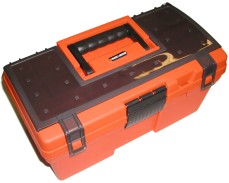

 The paragraph to the left if a clip from the M43’s very complete manual. Strain gages need very clean bare metal surfaces, so it would not be reasonable to expect one can be mounted on a blued surface, or stainless without serious chemical cleaning and roughing up the surface on either. One of the reasons I purchased a Ruger No. 1 was so I would not inflict expensive damage to my Guide Gun, and because it would be less difficult to refinish the stainless surface of the Ruger when the project was complete. Gage mounting is critical, and requires care to insure accuracy of readings when connected to the console. There are some other limitation for the equipment is regard to application. Very heavy barrels that exceed .500″ in chamber wall thickness may not read accurately as the dimensional change upon firing the gun may be too minor. The gage cannot be mounted easily on rotating surfaces such as a pistol cylinder, as there is a large 4′ long phone line size lead wire connected to the small gage that would get in the way. Auto pistols or any form of shrouded barrel would be out, as would any firearm that did not allow the gage to be mounted half way along the chamber, without being right up against the support of the firearm’s receiver. Straight cases read more accurately than bottle neck cartridges. My objective is not to downgrade the usefulness of the M43, but it is important to note this is not a piece of stick-on or bolt on equipment, it’s use will damage the firearm’s appearance and there are some restrictions in applications. Because I am putting a lot into the .45-70 handloading project, and this does represent something of personal interest in developing firearm knowledge through experimentation, the effort was worth the compromises.
The paragraph to the left if a clip from the M43’s very complete manual. Strain gages need very clean bare metal surfaces, so it would not be reasonable to expect one can be mounted on a blued surface, or stainless without serious chemical cleaning and roughing up the surface on either. One of the reasons I purchased a Ruger No. 1 was so I would not inflict expensive damage to my Guide Gun, and because it would be less difficult to refinish the stainless surface of the Ruger when the project was complete. Gage mounting is critical, and requires care to insure accuracy of readings when connected to the console. There are some other limitation for the equipment is regard to application. Very heavy barrels that exceed .500″ in chamber wall thickness may not read accurately as the dimensional change upon firing the gun may be too minor. The gage cannot be mounted easily on rotating surfaces such as a pistol cylinder, as there is a large 4′ long phone line size lead wire connected to the small gage that would get in the way. Auto pistols or any form of shrouded barrel would be out, as would any firearm that did not allow the gage to be mounted half way along the chamber, without being right up against the support of the firearm’s receiver. Straight cases read more accurately than bottle neck cartridges. My objective is not to downgrade the usefulness of the M43, but it is important to note this is not a piece of stick-on or bolt on equipment, it’s use will damage the firearm’s appearance and there are some restrictions in applications. Because I am putting a lot into the .45-70 handloading project, and this does represent something of personal interest in developing firearm knowledge through experimentation, the effort was worth the compromises.Ruger No. 1 .45-70 Test Mule Part 1
Tools for .45-70 handload development – Part I
Tools for .45-70 handload development – Part II

Email Notification